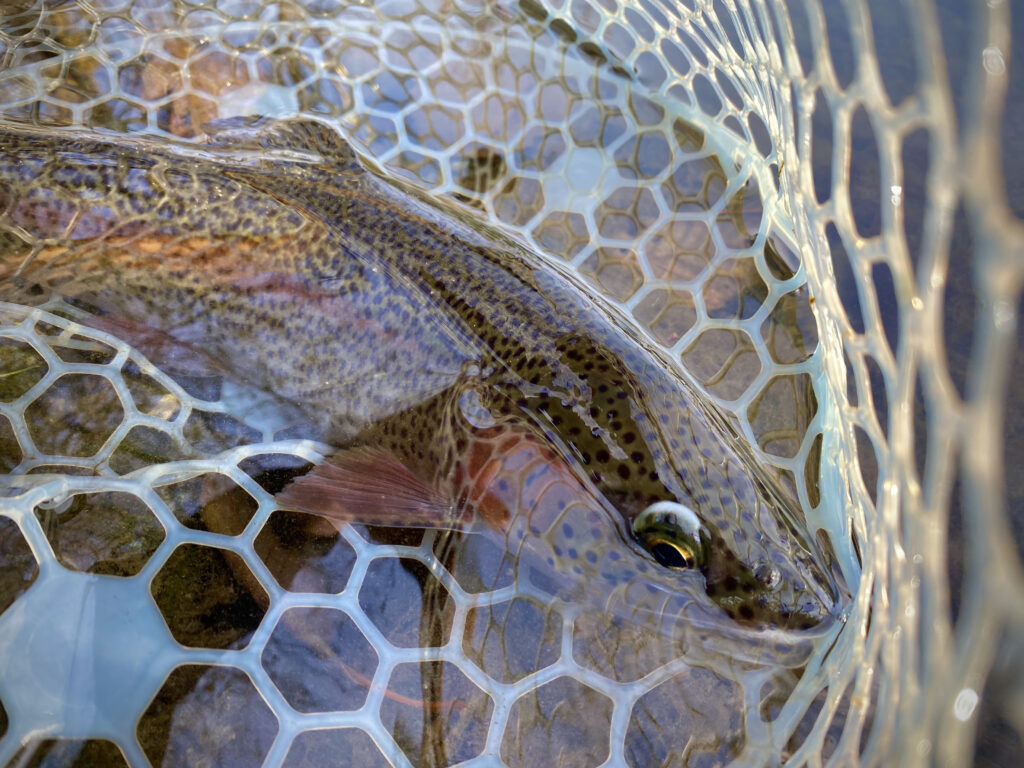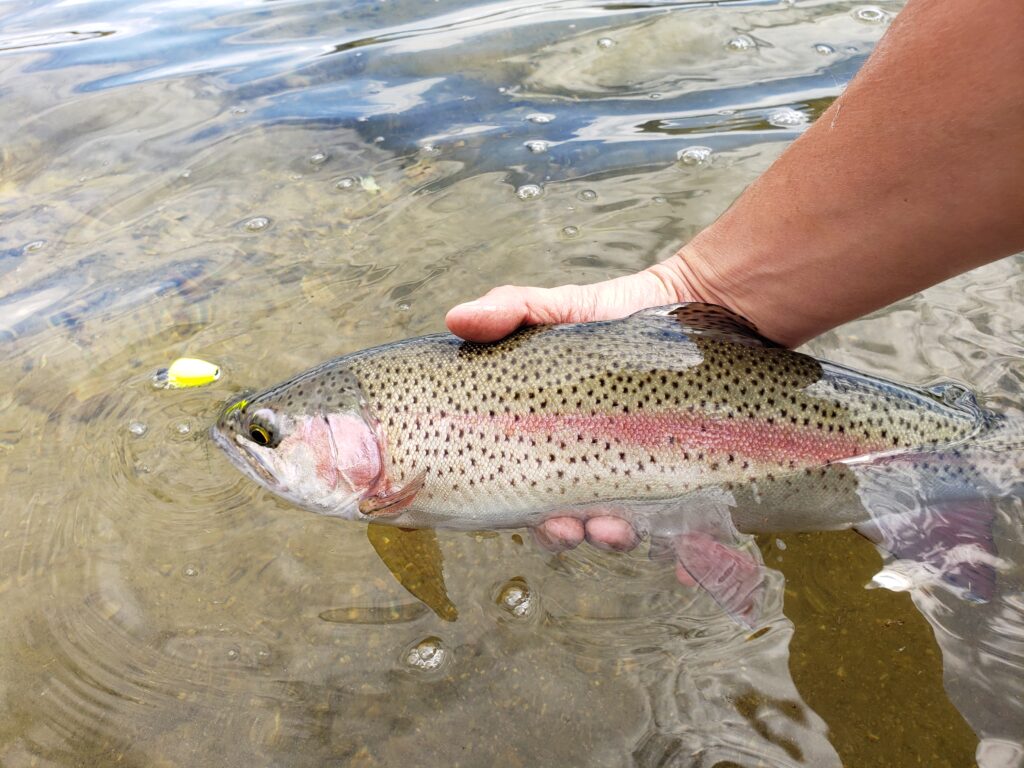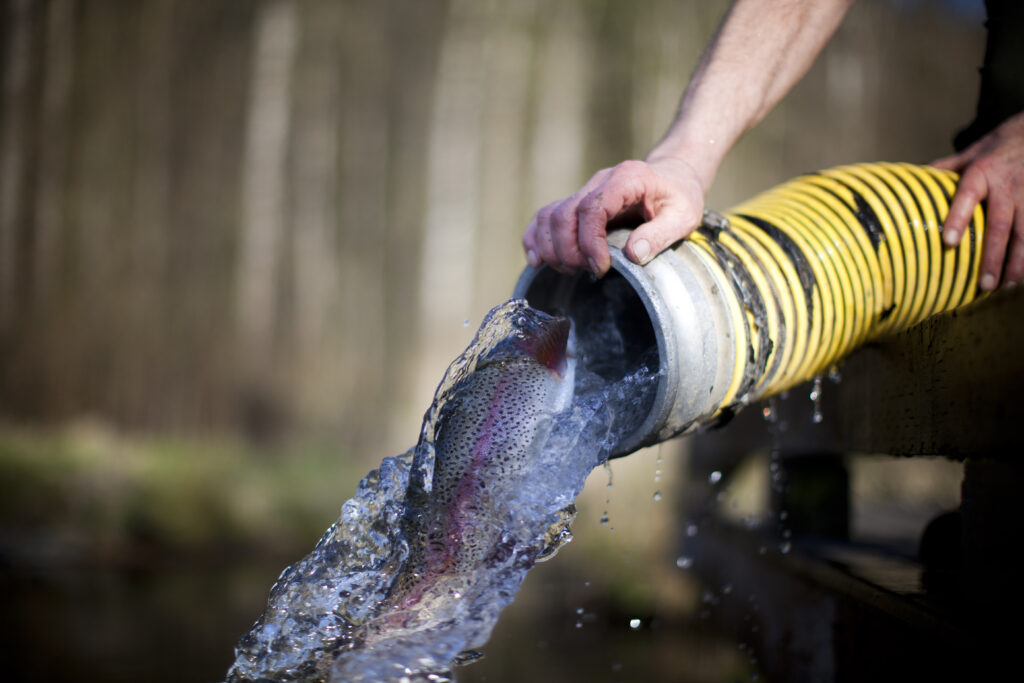Each spring and fall, Freshwater Fisheries Society of BC staff collect eggs and milt from mature fish for the provincial hatchery program. However, while most of the eggs for our hatcheries are gathered at lake and stream collection sites across B.C., we also rear and stock one domesticated strain – the Fraser Valley rainbow trout.
You’ve caught a Fraser Valley rainbow trout. Where did that fish come from?
Fraser Valley rainbow trout were first developed in Tacoma, Washington. The B.C. Provincial fisheries program purchased broodstock in the 1960s, and moved the fish to our Fraser Valley Trout Hatchery (hence the name). Fraser Valley rainbow trout get big fast; they were developed to have very rapid growth rates, which come from being extremely aggressive, with demonstrable risky behaviour. The result is a hefty fish that is bigger around the girth than other strains at the same length, and that doesn’t tend to be appropriately wary of predators.


Where did my fish’s parents live?
The Fraser Valley rainbow trout on your line is the offspring of a pair of trout raised in captivity. These willing-to-strike trout are an easy target for novice and young anglers, with a good fight that can satisfy anglers of all abilities. However, this risky behavior is not beneficial in the wild; to prevent interbreeding with wild fish, we only stock sterile (3n) Fraser Valley rainbow trout.
With a little help from Freshwater Fisheries Society fish culturists, our captive strain of Fraser Valley trout grow and spawn at the Vancouver Island Trout Hatchery in Duncan, B.C. Eyed eggs are then shipped around the province to our other facilities to be grown closer to their future homes.

What happened next?
At the hatchery, the dad’s milt was mixed with the mom’s eggs to fertilize them. After this process, the fertilized eggs were moved to the incubation room. The incubated eggs hatched and grew up into fingerlings in one of our hatcheries.
A select group of such fish babies are destined to be our captive broodfish – the next generation of parents – and will continue to mature in captivity until they are ready to spawn. The remainder are released in lakes as fingerlings or catchables, where they could end up on your hook.
A catchable? Aren’t all trout catchable?
Your fish was stocked into the lake in which you caught it, maybe as a fingerling but more likely as a “catchable.” Sure, most trout are catchable, if you have the right gear. However, when we call stocked fish “catchables” we are referring to their size when they are stocked, and in turn, their vulnerability to anglers. In general, our target size for catchables is about 225 grams, which provides for what’s sometimes called a “put-and-take” fishery. The Freshwater Fisheries Society puts them in, and anglers can take them out right away. While we know most of you would prefer to catch fish larger than that, at this size we can maximize the efficiency of rearing-space in our hatcheries and transport-space in our trucks, meaning we can produce and release more fish.
Catchables are an important component of B.C. fisheries for several reasons. The two most common reasons to stock catchable trout are winterkills and urban fisheries.

Which lakes are stocked with Fraser Valley Rainbow Trout?
When a lake suffer from winterkills, stocking catchables gives the lake a jump-start, and means that there will be ready-to-catch trout for that spring. Without them, stocked fry (one gram) or yearlings (eight to 16 grams) would need at least a year to grow in the lake before they are big enough to take a lure, meaning a year or two without catching fish in that lake.
Urban fisheries provide fishing in small lakes within or near city centres. These lakes often have good shore- or dock-fishing, which provide opportunities for new anglers to try their luck, as well as people without the time or means to access fishing in more remote settings. With urban lakes seeing so much fishing effort, stocked fish don’t last long. In fact, many urban lakes are re-stocked with catchable-sized trout many times throughout the year.
Every year, our hatcheries raise and release over six million trout, char and kokanee – from juvenile fry to catchable-sized fish. To see where we stock the Fraser Valley strain of rainbow trout, use the Detailed Stocking Report tool, and filter by Fraser Valley under Stock Strain.
This article is part of a series where we explore the origin of hatchery fish raised and released by the Freshwater Fisheries Society of BC.
Author: Kirstin Gale, Freshwater Fisheries Society of BC
Original Publish date: April 1, 2019
